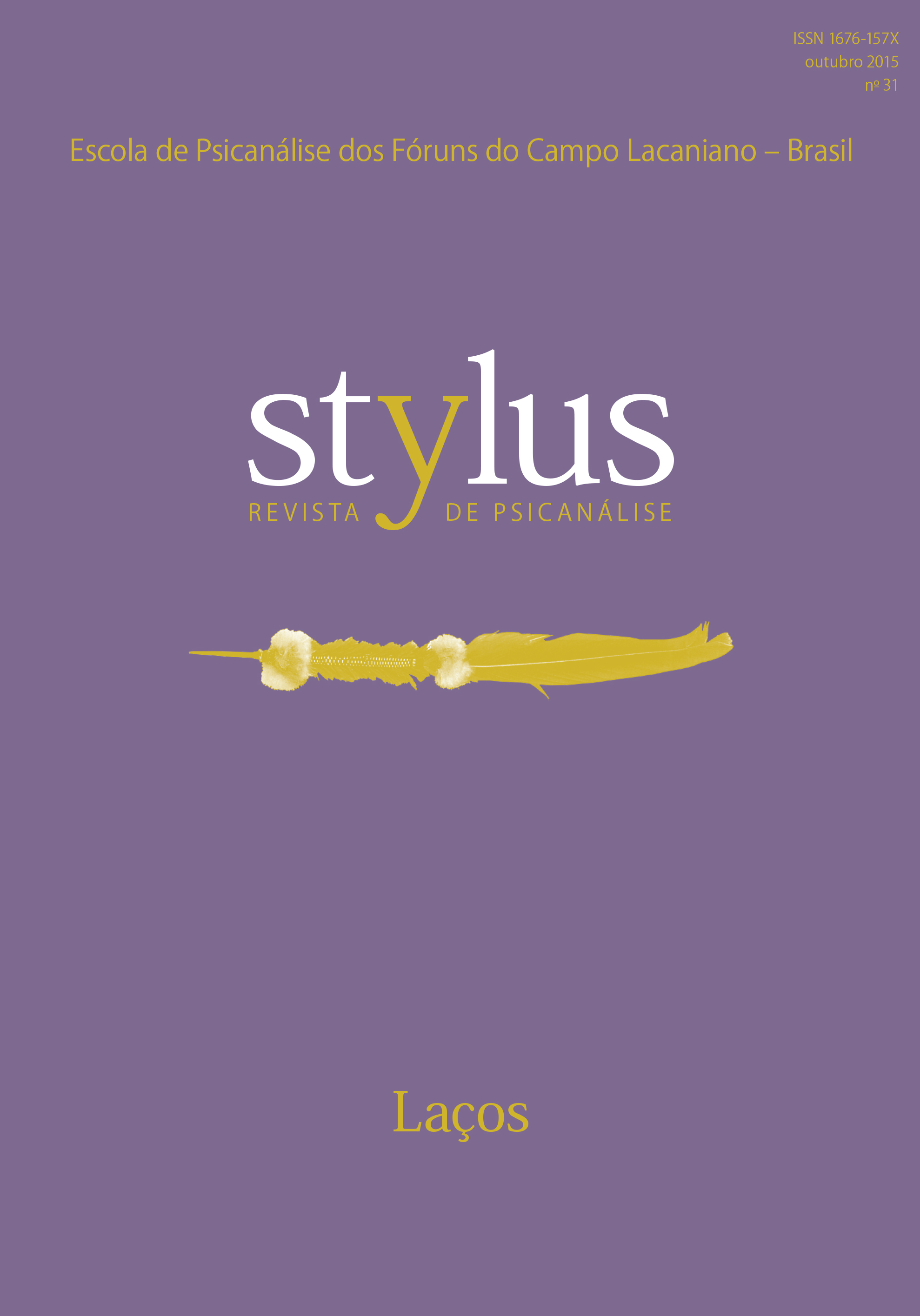Do amor de transferência à escrita de uma carta de amor
DOI:
https://doi.org/10.31683/stylus.vi31.654Keywords:
Love, transference, jouissance, principle of inexistence sexual relationship, analyst’s desireAbstract
From the transference love, the analyst is convened to occupy the position of object a countenance as the place that containing the agalma, a precious object that will open where the desire of the subject is questioned. This place can only be occupied from the analyst’s desire. In the course of analysis, the analysand undertakes a search for a knowledge about its truth, because the desire is revealed as nothing is known. However, between knowledge and truth there is a disjunction depending on the jouissance barrier, so that the subject is facing the language wall that representes its own castration and the inaccessibility of truth. The analysis work contains a real-access bet, that is, the wall transposition, which can only occur by means of fundamental fantasy. In L’Étourdit (1972), Lacan proposes psychoanalysis as a bewilderment that addresses the subject to the misconception of ab-sense, questioning the discursive regime of lalangue that operates beyond the phallic function in order to touch the Other jouissance. This possibility points 62 Stylus Revista de Psicanálise Rio de Janeiro no. 31 p.53-62 outubro 2015 to what Lacan tells us when he says that we must go beyond the unconscious by mistake in the Seminar L’insu que sait de l’une bévue s’aile à mourre (1976-1977). This paper questions about this bet of transposition of the language wall where knowledge, truth and jouissance are articulated. This question lead us to the hypothesis that it is possible to rely on the principle of inexistence sexual relationship for this crossing, in order to produce or write a love letter/ letter of love in the end of an analysis that considers the resonance of desire. Maybe this is the way for an emergence of a totally new desire, which is the desire of the analyst.
Downloads
References
de Lacan. Tradução de Claudia Berliner. Rio de Janeiro: Zahar, 2013. 96p.
BRUNO, P. Lacan, pasador de Marx. La invención del síntoma. Traducción de
Francisco Caja en colaboración com Rithée Cevasco. Barcelona: S&P ediciones,
2011. 462p.
BOUSSEYROUX, M. Os três estados da palavra: topologia da poesia. Conferência
ministrada na Universidade de São Paulo, USP em 25 de abril de 2013. Inédito.
LACAN, J. (1956) A coisa freudiana ou Sentido do retorno a Freud em psicanálise.
In: . Escritos. Tradução de Vera Ribeiro. Rio de Janeiro: Jorge Zahar,
1998, pp. 402-437.
_________. (1957) O Seminário Sobre “A carta roubada”. In: . Escritos.
Tradução de Vera Ribeiro. Rio de Janeiro: Jorge Zahar, 1998, pp. 13-66.
_________. (1960-1961) O seminário, livro 8: A transferência. Tradução de Dulce
Estrada. Rio de Janeiro: Jorge Zahar Editor, 2010.
_________. (1964) O seminário, livro 11: Os quatro conceitos fundamentais da psicanálise.
Tradução de M. D. Magno. Rio de Janeiro: Jorge Zahar Editor, 2008.
_________. (1972) O aturdito. In: . Outros escritos. Tradução de Vera Ribeiro.
Rio de Janeiro. Jorge Zahar Editor, 2003. pp. 448-497.
_________. (1971-1972) O seminário: O saber do psicanalista. Tradução de Ana
Izabel Corrêa, Letícia P. Fonsêca e Nanette Zmery Frej. Publicação para Circulação
Interna do Centro de Estudos Freudianos do Recife.
_________. (1972/1973). O seminário, livro 20: Mais, ainda. Trad. M. D. Magno.
Rio de Janeiro: Jorge Zahar, 2008.
_________. (1973). Televisão. In: . Outros escritos. Rio de Janeiro. Jorge
Zahar Editor, 2003. pp. 508-543.
NICOLESCU, B. Contradição, lógica do terceiro incluído e níveis de realidade.
Trabalho apresentado em Ateliers sur la contradiction – Nouvelle force de développement
em science et societé. École N. S. Des Mines. Saint-Etienne, de 19
a 21 de março de 2009. Inédito. Disponível em: http://www.emse.fr/aslc2009.
Acesso em: 27 de abril de 2015.
Downloads
Published
How to Cite
Issue
Section
License
Ao encaminhar os originais, os autores cedem os direitos de publicação para STYLUS.
Os autores assumem toda responsabilidade sobre o conteúdo do trabalho, incluindo as devidas e necessárias autorizações para divulgação de dados coletados e resultados obtidos, isentando a Revista de toda e qualquer responsabilidade neste sentido.



